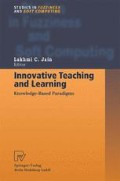Abstract
The more commonly used Artificial Neural Network models are first characterized. These characteristics — training parameters and the like — are related to high-level language constructs (C/C++). The necessity of Graphical User Interfaces, from an educational perspective, is highlighted. Experiences are then recounted gained from a decade of teaching a graduate-level course on ANNs. Representative public domain and commercial ANN software simulators are covered (some of the former types accompanying ANN textbooks). Particular emphasis is placed on BackPropagation/Multi-Layered Perceptrons using NeuralWare software.
Access this chapter
Tax calculation will be finalised at checkout
Purchases are for personal use only
Preview
Unable to display preview. Download preview PDF.
References
Fulcher, J. (1997), “Image Processing,” Chapter F1.6 in E. Fiesler and R. Beale (Eds.), Handbook of Neural Computation, Oxford University Press, New York.
McCulloch, W. and Pitts, W. (1943), “A Logical Calculus of the Ideas Immanent in Nervous Activity,” Bulletin Mathematical Sciences, Vol. 5, pp. 115–133.
Rosenblatt, F. (1958), “The Perceptron: a Probabilistic Model for Information Storage and Organization in the Brain,” Psychological Review, Vol. 65, pp. 386–408.
Minsky, M. and Papert, S. ( 1969, 88), Perceptrons (expanded ed), MIT Press, Cambridge, MA.
Werbos, P. (1994), The Roots of Backpropagation, John Wiley and Sons, New York.
Blum, A. (1992), Neural Networks in C++: an Object-Oriented Framework for Building Connectionist Systems, John Wiley and Sons, New York.
Masters, T. (1993), Practical Neural Network Recipes in C++, Academic Press, San Diego, CA.
Welstead, S. (1994), Neural Network and Fuzzy Logic Applications in C/C++, John Wiley and Sons, New York.
NeuralWare Inc. (1995), Supplement for Professional II/Plus V5.1, Technical Publications Group, NeuralWare Inc., Pittsburgh, PA.
Beale, R. and Jackson, T. (1990), Neural Computing: an Introduction, Adam Hilger, Bristol, UK.
Aleksander, I. and Morton, H. (1990), An Introduction to Neural Computing, Chapman and Hall, London, UK.
Dayhoff, J. (1990), Neural Networks: an Introduction, Van Nostrand Reinhold, New York.
Pao. Y. (1989), Adaptive Pattern recognition and Neural Networks, Addison Wesley, Reading, MA.
Wasserman, P. (1989), Neural Computing: Theory and Practice, Van Nostrand Reinhold, New York.
Fulcher, J. (1992), “Experience with Teaching a Graduate Neural Networks Course,” Computer Science Education, Vol. 3, No. 3, pp. 297–314.
Fulcher, J. (1993), “Comparative Neural Network Book Review — I,” ACM Computing Reviews, Vol.34, No.10, pp. 54–56 [93010009].
Fulcher, J. (1993), “Comparative Neural Network Book Review — II,” ACM Computing Reviews, Vol.34, No.5, pp. 230–233 [93050266].
Wasserman, P. (1993), Advanced Methods in Neural Networks, Van Nostrand Reinhold, New York.
Haykin, S. (1999), Neural Networks: a Comprehensive Foundation (2nd ed.), Prentice Hall, Upper Saddle River, NJ.
Brown, J.S., Collins, A. and Duguid, S. (1989), “Situated Cognition and the Culture of Learning,” Educational Researcher, Vol. 18, No. 1, pp. 32–42.
Lave, J. and Wenger, E. (1991), Situated Learning: Legitimate Peripheral Participation, Cambridge University Press, Cambridge, UK.
McLellan, H. (Ed.) (1996), Situated Learning Perspectives, Prentice Hall, Englewood Cliffs, NJ.
Harel, I. and Papert, S. (1992), Constructionism, Ablex, Norwood, MA.
Oakeshott, M. (1962), Rationalism in Politics, Methuen and Co., London.
Fulcher, J. (1992), “McClelland, J. and Rumelhart, D., ”Explorations in Parallel Distributed Processing: a Handbook of Models, Programs and Exercises (PC/Macintosh), MIT Press, Cambridge, MA, 1988(9),“ ACM Computing Reviews, Vol.33, No.11, pp. 593–594 [9211–0841].
Miyata, Y. (1991), A User’s Guide to PLANet V5.7, Dept Computer Science, University of Colorado, http://boulder.colorado.edu.
Leighton, R. and Weiland, A. (1998), The Aspirin/Migraines Software Tool Users’ Manual V6.0, Mitre Corp, http://taylor.digex.net/am6.
Zell, A. et al. (1995), Stuttgart Neural Network Simulator User Manual V4.1, Institute for Parallel and Distributed High Performance Systems, University of Stuttgart, Germany, http://www-ra.informatik.uni-tuebingen.de/SNNS/.
Fulcher, J. (1998), “Laboratory Support for the Teaching of Neural Networks,” Intl. J. Electrical Engineering Education, Vol. 35, No. 1, pp. 29–36.
Hagenbuchner, M. and Fulcher, J. (1997), “Noise Removal in Ionograms by Neural Network,” Neural Computing and Applications, Vol. 6, pp. 165–172.
Fisher, R. and Fulcher, J. (1998), “Improving the Inversion of Ionograms by Combining Neural Networks and Data Fusion Techniques,” Neural Computing and Applications, Vol. 7, pp. 3–16.
Fulcher, J. (1989), An Introduction to Microcomputer Systems: Architecture and Interfacing, Addison Wesley, Reading, MA.
NeuralWare (1996), Using NeuralWorks, NeuralWare Inc., Technical Publications Group, Pittsburgh, PA.
MatLab (1996), Neural Network Toolbox for use with MatLab, The MathWorks Inc., Natick, MA.
Fulcher, J. (1994), “A Comparative Review of Commercial ANN Simulators,” Computer Standards and Interfaces, Vol. 16, No. 3, pp. 241–251.
Author information
Authors and Affiliations
Editor information
Editors and Affiliations
Rights and permissions
Copyright information
© 2000 Springer-Verlag Berlin Heidelberg
About this chapter
Cite this chapter
Fulcher, J. (2000). Teaching Course on Artificial Neural Networks. In: Jain, L.C. (eds) Innovative Teaching and Learning. Studies in Fuzziness and Soft Computing, vol 36. Physica, Heidelberg. https://doi.org/10.1007/978-3-7908-1868-0_7
Download citation
DOI: https://doi.org/10.1007/978-3-7908-1868-0_7
Publisher Name: Physica, Heidelberg
Print ISBN: 978-3-7908-2465-0
Online ISBN: 978-3-7908-1868-0
eBook Packages: Springer Book Archive

